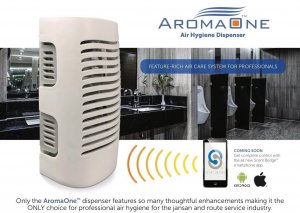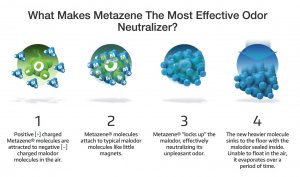Blending smells with music being played in real time at clubs and concerts concerns a phenomenon known as aroma jockeying. This is a logical outgrowth of the need today for a a new edge of discovery, so to speak, that involves pushing the experience envelope of live entertainment to expand sight and sound to new, […]
The Drawbacks of Masking Odors Vs Neutralizing With Metazene
The challenge of controlling vaporous malodors in commercial spaces of all types is nothing short of formidable, and it’s a task not intended for the faint of either heart or nose.
Odors in any commercial environment can be an enormous problem for any business in any industry that interfaces with the public, and they can be particularly destructive to public impressions when they proliferate in restrooms.
While no one may think specifically about scent when entering a public restroom, people without doubt want to walk into a bathroom that smells fresh, pleasant and clean — and the reverse can have devastating effects upon repeat business, company employee morale and bottom line.
The main goal of odor removal must be to eradicate the vaporous odors at their molecular level, not mask them with powerful fragrances, which just creates an even funkier concoction of stink.
Most business owners and managers don’t realize that odor control via neutralization can be a very complex process that requires scientific skill and precision.
One health specialist claims: “From Friday through Sunday, there is bacterial growth going on in the garbage left there since the Thursday cleanup. Those problems are usually solved by making sure disposable garbage does not sit around for three days before it’s emptied.”
In the case of restroom odor removal, and according to Lynn Krafft, CEO of Krafft Cleaning Service in Watertown, New York: “If you sniff a new toilet on display at a store, it’s not going to smell like anything. The smell of clean is not pine oil, lilacs or roses — it is just air. Odor removal in restrooms should not involve buzzing it with aerosols or putting smelly cakes in urinals. The goal should be to remove all odor sources.”
So how do you effectively remove odors in commercial environments if you’re a business owner, Jan-San distributor, air care distributor or route service operator?
Read on as our team explains the scientific power of Metazene, provides five drawbacks to simply masking odors and underscores why true molecular odor neutralization (over masking them) is the only surefire way to achieve absolute vaporous odor control.
Historical Aspects To Odor Control
Living with odors has been a necessary evil since the dawn of mankind. It wasn’t until about 200 years ago that some odor control measures in the form of garbage collection and sewage systems were introduced to the United States.
The invention and development of aerosol air fresheners in the late 1940s brought about a competitive surge of research among the top twenty firms involved in selling aerosol air fresheners motivated by the drive to create better formulations than their competitors.
Perfumes did nothing to control malodor, and were known as reodorants rather than deodorants. The industry craved for more powerful ingredients, but the dilemma was to develop a substance that would eliminate air-borne odor chemically and yet not affect any desired pleasing odor.
During the 1960s, cleaning methods became more complex, but the importance of bathroom hygiene and establishing a company sanitation standard was still not at the forefront of business concerns. Public perception was instead mired into appearances. During the 1970s, this attitude gave way to active environmentalism, promoting the introduction of proven and ‘sustainable’ products, Earth Days and anti-litter campaigns.
It was during this epoch that a real understanding of how some elements, such as formaldehyde, which was rampantly used in odor-control products, negatively affected both the environment and human health. Within the bathroom hygiene industry, this led to the logical re-evaluation of the meaning of clean and how to achieve it, but Air-Scent was already ahead of the rest, for none of its products contain harmful formaldehyde.
Since the mid 1950s and up until the present day, advances in technology have opened up new doors in the field of industrial science and the world of superior odor control and ambient air-care.
The 1980s and 1990s were marked as eras of growing concern over the spread of diseases, especially but not exclusively the AIDS virus. This helped to crystallize the industry’s need to “clean for health.” Company bathrooms were now equipped with anti-bacterial soaps and touch-free towel dispensers.
Today, such practices and products are commonplace, but there are still many business managers and owners who remain in the dark about the ineffectiveness of masking rather than destroying malodors.
How Foul Odors Lead To Loss Of Revenue
A foul-smelling restroom in a restaurant can mean a significant loss of business. Consumer reviews can be completely negative after a malodorous restroom experience.
It can overshadow all other thoughts about the finest service, excellent food and ambiance. In a recent survey, a Harris Poll concluded that 97% of Americans would not return to a restaurant where they had a bad experience in the restroom.
Commercial spaces, schools and universities need odor control and odor management, but they need different strategies and solutions because of the ages of the individuals involved. Offices and retail spaces deal mostly with adults but schools concern children with diverse tolerance levels.
The main goal in these types of spaces is the same: to eradicate malodor completely from the premises.
There are four basic principles required to manage malodors. They are: the application of a superior odor control product; pinpointing the exact source of the odor and eliminating it; frequent cleaning; and the regular maintenance of cleaning equipment.
Our chemists and chief perfumers see the irony that pervades many instances when business owners, seeking to cut operating costs, consider a reduction of expenditures in their cleaning budgets. This is self-defeating, and can be a fatal miscalculation.
The repercussions of foul odors in commercial restrooms in any type of business that interfaces with the public are certain to cause a decrease in customer traffic and satisfaction and a loss of business standing within a community. This culminates in losses to that all-important company bottom line.
Five Problems Associated With Simply Masking Odors
While to some this might seem a bit obvious, shortsighted business owners and mangers often don’t look at the total picture in their haste to maintain operations at the lowest cost possible.
The true tragedy of this approach lies in the fact that in the end, costs and losses are greater when companies just mask foul restroom odors instead of facing them head on and eliminating them for good.
Industrial settings evoke many odors of different types, which are often produced by chemical breakdowns of microorganisms, bacteria, mold and mildew.
Covering them up is simply not a desirable odor control method for the simple reason that it doesn’t work in the long run. It is, at best, a temporary fix for a permanent problem.
The following are some of the reasons such actions do not work well.
1. Masking Odors Results In The Need For More Dispensers
Masking odors is self-defeating for any company because in the end, more dispensers will be required to tackle the coverage area, resulting in increased expenditures.
2. Masking Odors Requires The Use Of Overpowering Fragrances
The problem here is that too much really is too much in more ways than one. In most instances, the harsher application transforms the fragrance into an unpleasant replacement. This is not optional when masking fragrances because covering up the foul smell will only happen if the chosen scent is turned up to the nth degree.
3. Leakage From Unit When Masking Odors
This occurs as a direct result of masking odors because the fragrance must be stronger than normal in order to effectively (if only temporarily) mask the offensive odor. The result can be an overflow of powerful scent into other adjacent rooms, such as office spaces and dining areas. This can be crucial to customer satisfaction and often causes complaints that are hard to live down from both consumers and employees.
4. Masking Malodor Often Creates An Even Funkier Smell
The smell that results from leaky units when scent is covered up rather than eliminated can be worse than even imagined. Bacterial molecules run amuck within a unit that is stretched to operate beyond its capacities and no one who takes a whiff of the interior of a toilet with such a faulty unit is likely to ever venture inside again.
5. Masking Doesn’t Eliminate Malodors
It’s been said many times and many ways, but the facts will never change. Masking odors in toilets is comparable to trying to make a hole in water. It simply is not effective and can only result in problems and more costly solutions. Bathroom malodors present the perception that a company doesn’t care about restroom cleanliness or the health of its clients and employees.
Air-Scent: Master Provider Of Odor Control in Large Spaces
Maintaining odor control in large commercial areas is more challenging than smaller office spaces. The scope of needed potency in a large facility is simply too much for the average air-freshener. More space means more hiding places for lurking gram-positive odor molecules.
But malodors have met their match with the Aroma Beam Scent Machine, which can effectively diffuse scent for areas as large as 50,000 cubic feet and replace them with a pleasant aroma. It is also easy to use and can be controlled via an app.
The Superior Power of Metazene Vaporous Odor Neutralizer
This colorless additive is the epitome of “true odor neutralization.” Its evolution is closely allied to both advances in technology and science and the demands of the modern consumer for the creation of a powerful weapon to eradicate malodors completely rather than disguising them with a temporary bouquet of lightly fragranced air-care products.
Metazene is, without question, the most effective and environmentally-preferred odor-neutralizer on the market today.
Metazene’s ability to control air-borne odors is accomplished via a chemical reaction that occurs because of its extremely low vapor pressure. Heavier odor molecules bond with the Metazene and this causes them to eventually evaporate.
Its primary reputation as an effective counteractant for restroom malodors has been so successful that its use has expanded into many plant-processing operations. This has opened the door to a myriad of marketing opportunities. Commercial establishments are becoming more and more aware of the need for odorless deodorization programs to maintain healthy work environments.
Some examples of industrial applications include: the persistent odors that result form the repeated use of the same products. The stale food odors in the halls of apartment complexes are a good example. This can include: sauces, boiled cabbage, fish, garlic, onions as well as odors from fecal, urine and emeses. All of these and others can be can be permanently removed when the offending air is sprayed with products containing Metazene rather than perfume sprays which only work for a little while.
Even more, Metazene’s unique properties also offer the ability to provide neutral, fragrance-free air freshening options.
Our researchers and chemists at Air-Scent are constantly at work developing new and improved methodology for our formulations. They work within our 85,000-square-foot facility located the great city of Pittsburgh and are equipped with the most cutting edge, state-of-the-art scent diffusion technologies and advanced equipment that money can buy. These include the latest in: gas chromatography, mass spectrometry, headspace analysis, distillation, extraction and quality control technology.
The Future of Air-Scent and Metazene
In continuous operation for more than seventy years, our superior odor control and odor management systems and products infused with Metazene are the most effective found anywhere in the world, and they can permanently tackle any environmental odor or air freshening issue.
While there’s no telling exactly what the future will bring, it is a good and highly educated guess that technology will continue to transform the landscape of ambient air-care and scent marketing for commercial enterprises and that Air-Scent and our superior products will be at the forefront of these innovations for a long time to come.
Call us today for an odor-free tomorrow! Let our solutions help you prepare a regimen that will keep your facility, or your client’s facilities, fresh and clean and all times.
Final thought about scent: Nothing can beat the smell of dew and flowers and the odor that comes out of the earth when the sun goes down. ~ Ethel Waters
You May Also Be Interested In
In the world of retail, the power of ambiance cannot be underestimated. Discover how ambient scenting and thoughtfully chosen fragrances can captivate customers and elevate the shopping experience, leading to increased sales and heightened emotions within jewelry stores.
In maintaining a hygienic and pleasant environment, regular trash chute cleaning proves indispensable for any property. Equally crucial are commercial-grade air freshener systems, ensuring continuous freshness, and eliminating unpleasant odors that may deter occupants and visitors. Discover the vital importance of these two essential practices in this article.


